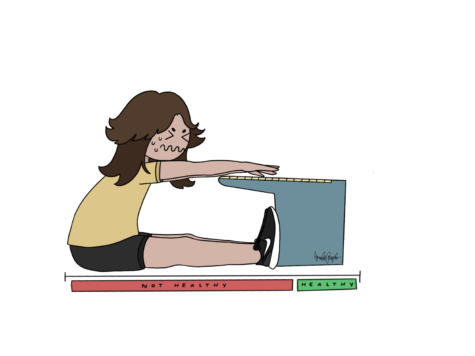Fitness tests: outdated
March 18, 2022

I remember the first fitness test I ever took. I was in 6th grade, and panicking. It was about three months into my first year of middle school, and coming up in a week, was fitness testing. They expected me to be able to do seven pushups! I had never even done more than five of the knee-pushups in a row before. Well, as you can expect, the day came and I failed miserably; I managed to do one shaky, horribly formed pushup, then promptly crashed to the floor, panting. Similarly, when taking all of the other tests, I either just barely passed, or failed miserably. Ever since then, fitness testing has been the bane of my existence. Every year, when it comes around, I find myself dreading those horrible few days. What I still don’t understand though, is why we need the fitness test at all.
State-sanctioned testing is such an outdated method of measuring the health of students or anyone else for that matter. When doing fitness testing, a student is measured by their gender and age. For example, a 14-year-old girl has to be able to do 18 curl ups, while a 13-year-old boy has to do 21. The way that these guidelines are set are very strict, and don’t take into account many factors that could account for a student’s inability to reach a certain standard. Instead of having these tests, ENS should put more focus on creating, and achieving goals, not rigid scores.
Things like genetics can affect how tall, short, strong, or fast a student is. If a student has naturally long legs, the sit and reach test will be harder for them, but if a student has shorter legs, the running/pacer gram tests will be harder. Leg length is obviously not something a student can improve.
Another thing that can affect a student’s fitness test score is the test itself. Many teachers lack the equipment, or the equipment just doesn’t work. You and I have both seen it, the out-of-battery pushup counters and broken sit-and-reach stations. Even the tests that rely on t students to keep track are prone to human error. People can lose track of their count, make a mistake while counting, ect.
Another important element to passing the fitness test is time spent outside of school exercising. Most of the activities in ENS are sport-based, and even in others, like the weight room/fitness lab, the activities done are not strictly regulated by the teacher. A person could have an impressive sit-and-reach score, and still fail the curl-up test. The element of choice in ENS is great for discovering which areas of fitness you enjoy or need to work on, but most of the activities that are tested are never explicitly practiced in class.
Some students, for a multitude of reasons, don’t exercise outside of school. Maybe their parents can’t afford to put them onto a club sports team, or maybe they’re bogged down by homework, or struggle with mental health and lack the mental energy to get a consistent exercise routine going. Overall, there could be thousands of reasons a student can’t exercise outside of school.
Let’s face it, even when putting in lots of effort during the allotted ENS period, running the mile once every few weeks and playing basketball for a couple hours on Friday does not automatically mean being healthy and fit. While the time in class is helpful for improving students’ fitness, it is not the end-all-be-all of fitness. Since that is the case, the fitness tests make no sense, for it doesn’t seem right to test people on things that they can’t achieve in class.
Lots of factors can affect how well you do on the fitness test, and even more negative effects can stem from the testing; fitness testing can affect the student’s sense of self-worth and confidence in their abilities. Because of the scoring process, children feel that when they don’t meet those standards, they somehow are lesser than their peers that do pass the tests. Grading students, in any sense, on things that they cannot change is horrible for self-esteem.
Additionally, while there are many reasons why students could fail the tests by no fault of their own, there is also the question of why we do them in the first place. Being able to run a mile doesn’t necessarily mean someone is healthy. Passing the fitness test does not automatically mean you are the picture of health, so why do we put stress on it in ENS, a class all about being healthy?
ENS is quite unlike Math, where the teacher sets certain standards, formulas or procedures that students have to be able to perform to pass the class. ENS is more fluid, with individuals setting and achieving their own specific fitness goals. And usually, class objectives reflect this; regularly, there aren’t many stiff grading processes, with the majority of the grades being based on participation. Fitness testing is in direct opposition to a student-driven approach, however.
Instead of a rigid test, with set scores and strict guidelines, assessments should be more open and relaxed, and based mostly on improvement, rather than set scores. It would be much less stressful for the students, easier for the teachers, overall fairer, and a more accurate representation of the students’ drive.


